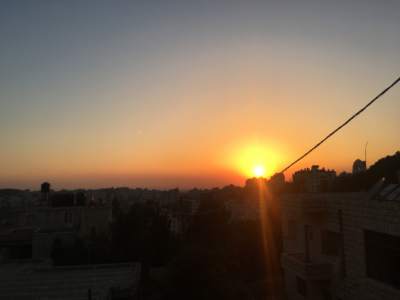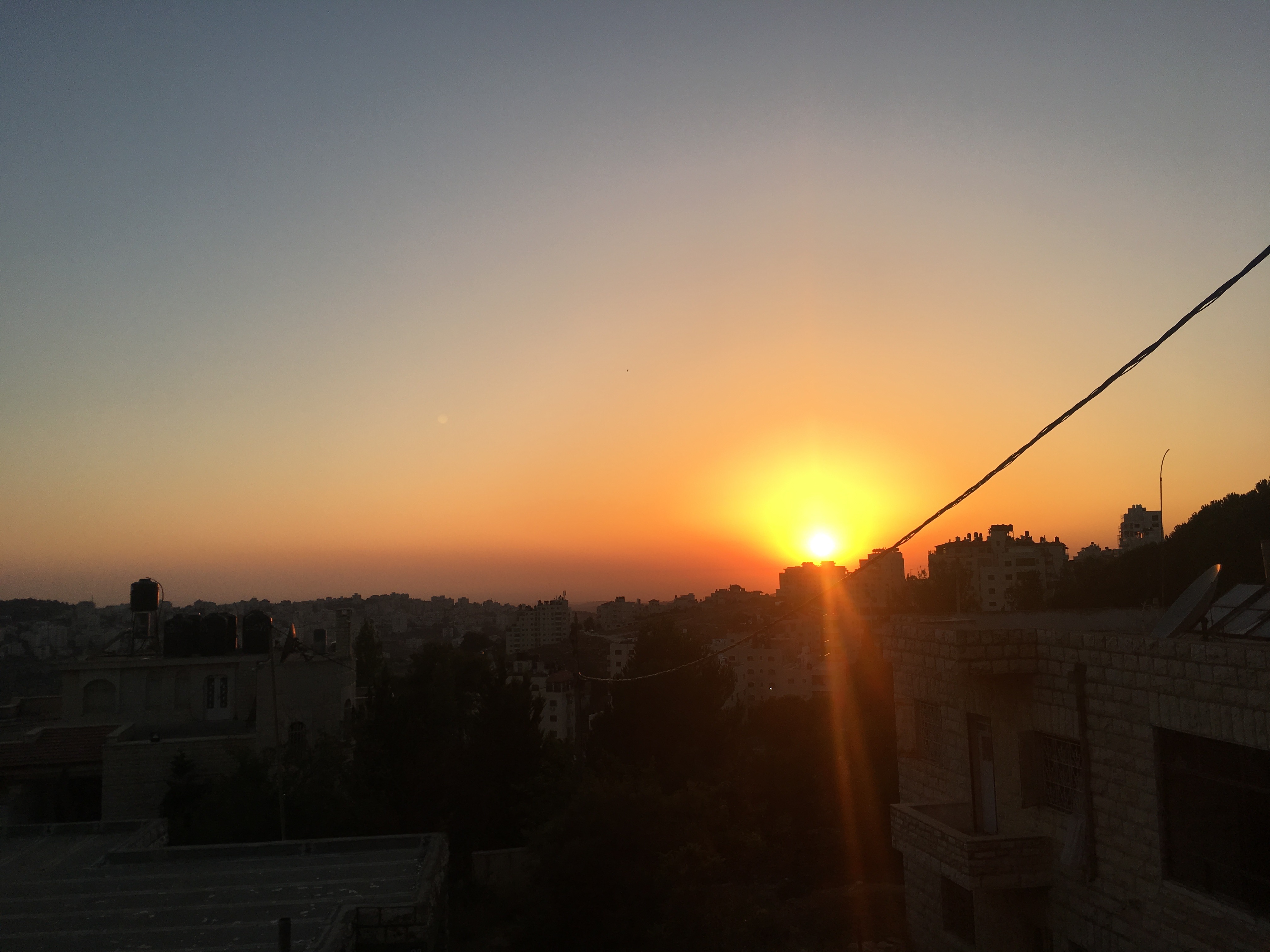H. meets me in the Menarah at around 4:30; I am late, and she, in the tradition of everyone I have met here, is beyond gracious. We walk down Rukab Street towards Rukab Ice Cream. It’s the oldest ice cream shop in Ramallah and so notoriously good that the street is named after the shop rather than vice versa. I have only tried Baladna, their competitor, created by a close family friend who stole the Rukab recipe and betrayed the family’s trust, so the legend goes. However, as soon as we are inside and the unbelievably creamy, impossibly stretchy Oreo ice cream hits my tongue I feel my allegiance shift.
H. and I walk with our ice cream through the gold-laden 5 o’clock sunshine. Her with her cup, me with my cone, her 18, me 20, her Palestinian, me American, her Muslim, me Jewish. I don’t think about it until later, about how many people around the world believe that any conversation between the two of us should not be happening, how many more believe that even if it should it could not. I don’t think about the way I backhandedly laugh at that notion; knowing the things that I know, the people I know, and how much of what I know has been informed by the remarkable, courageous, and oftentimes Palestinian people I know.

H. and I sit on the side of an outdoor basketball court and watch kids kick around a soccer ball. We talk books, college, our futures. She is starting this fall at Birzeit and wants to study English with a minor in business. I notice for both of us our futures seem to take on a hazy optimism; we can’t quite make out the details yet, but we trust in our ability to construe them into something we like. I tell her about my interests, how I am triple majoring in English, women’s studies, and Jewish studies, how it’s not as hard as it seems, and all my usual talking points.
I do not know if she knows I am Jewish, but I feel no hesitation in telling her. Once again it does not occur to me until later that many would be taken by the fact that her shock came not from the faith I have chosen to study, but from the fact that I have three majors. On the walk back to my apartment she points out a Palestinian art and history house huddled on our left below street level and asks me if I want to come in; my answer is of course, yes.
I am able to recognize now that the building is a traditional style of Palestinian architecture influenced by the Turks during the Ottoman Empire; built of old stone with low arches. There is a little patio out front, shielded from the street above and decorated with lush green plants, Palestinian flags, and local art. Two older men sit side by side near the entrance, drinking out of mugs and speaking a low, calloused Arabic.
Inside, H. introduces me to the owner, who she knows, and leads me down a small set of stairs where prints of paintings are displayed. She rubs her finger against the canvas and explains that you can’t feel the paint, real paintings are kept upstairs. The air has a wet, earthy smell to it that I would expect in my east coast neighborhood rather than here in the desert. The beige stone paired with the light creates an almost honeyed effect and the prints on the walls are all vibrant splashes of color.
I walk through the art, all proudly Palestinian and full of equal parts resistance and resilience. A beaming white horse surrounded by orange brown canyons is, as a plaque informs me, a symbol of Arab strength and pride. The horse is surrounded on all sides and unable to recognize its potential or see its dreams. I think back to mine and H.’s earlier conversation on what we want to do in the future, the fuzziness I had sensed in her description, and that I had recognized in myself as well. I realize now the difference of our canyons. How for H., having laziness, self-doubt, and insecurity be your only barriers must be a light and lovely thing.
She shows me her favorite painting; a stunning Jaffa in all its magnificent, pre-occupation colors. The hue of the oranges like the bright sunny center of a just slightly undercooked hard-boiled egg, the sea a deep blue so profound and timeless I’m stunned at how one turquoise could convey so much, the bright white of the crashing waves, how at the curve of their climax they take on the shape of horses’ hooves.
Then I see the painting to the left, by the same artist, and for a moment it is just color and shape. But then, the keen eye my art historian father has instilled in me begins to take apart the pieces. In the background, the old city faces the sea, Damascus Gate tucked in the far right corner. To the left are ships black as midnight, unloading hordes of huddled masses from the blueblack sea to the yellow white sands of Palestine. Below them are the bulldozers, swallowing homes and olive trees alike, displacing crowds of faceless people with their hands in the air, supervised by tiny shadowed soldiers. In the bottom left corner a little boy with only one leg hobbles away on crutches from the massacre of his land, revolutionaries are hung from trees, and in the center, right where the eye is drawn to, is a circle of deep blue: joyous, celebrating Jews.
I am aware of H. watching me take apart this painting, and perhaps her desire to move onto the next, to show me more, but some ancestral chord in me has been plucked and I cannot move. The men in the middle are celebrating on skulls, white as the horses’ hooves and quickly taking shape into tombstones and below that, bleeding flaccid bodies. The men with their blueblack beards and blueblack peyos blow a shofar like a battle horn and lift up machine guns in praise. Their sharp noses point skywards and I see one man in the bottom corner. Machine gun pointed towards the heavens, a tallit exactly like the one I wore to my bat mitzvah shrouds his sinister head, and his face is turned towards me. An age-old symbol of deceit, danger, power, Jewry, me.
On the walk home, we stop to admire the stunning mountainous view H. has grown up around and I try to maintain a semblance of normalcy. I think I am most hurt because of all the antisemitism I have seen in my life: the jokes throughout middle school; the Nazi flag being sold in Nowhere, Pennsylvania; the swastika carved on a high school desk. And all that I haven’t seen: the man on a bus who asked my not-yet-mother if she had horns; the kids who chanted at my not-yet-father what to do what to do what to do with the goddamn Jews; the whim on which I looked up my last name in the Yad Vashem Holocaust memorial database and found names too many to count – none of it, not one bit, ever felt deserving.
But here, in Palestine, after seeing soldiers and settlers and separation walls; after seeing the over 70-year-long ache in the eyes of my remarkable, courageous, Palestinian friends – it does. And the truth is I am so hurt. Suddenly it doesn’t matter if H. does not care that I am a Jew, or if all my new friends were so excited to talk to me about my faith and prove to me they are not the bigoted monsters dozens of paintings and papers and news reports have shown them as. It does not matter that in the hours after, I will remind myself that my pain and discomfort and guilt has nothing on decades of occupation.
I am stuck; in my Jewish body with my Jewish nose and Jewish hair, the same as the men in those paintings. I am stuck in my Jewish history of Jewish hurt and Jewish loss. I am nothing but the product of my parents’ confusion and my grandparents’ paranoia and my great-grandparents’ heartbreak, one of who’s name H. calls from the road up ahead, asking me to come.
Nesha Ruther is a poet hailing from Takoma Park, Maryland. She was a member of the 2015 DC Youth Slam Team and a 2016 YoungArts winner in spoken word. She currently attends the University of Wisconsin Madison as part of the tenth cohort of First Wave.

